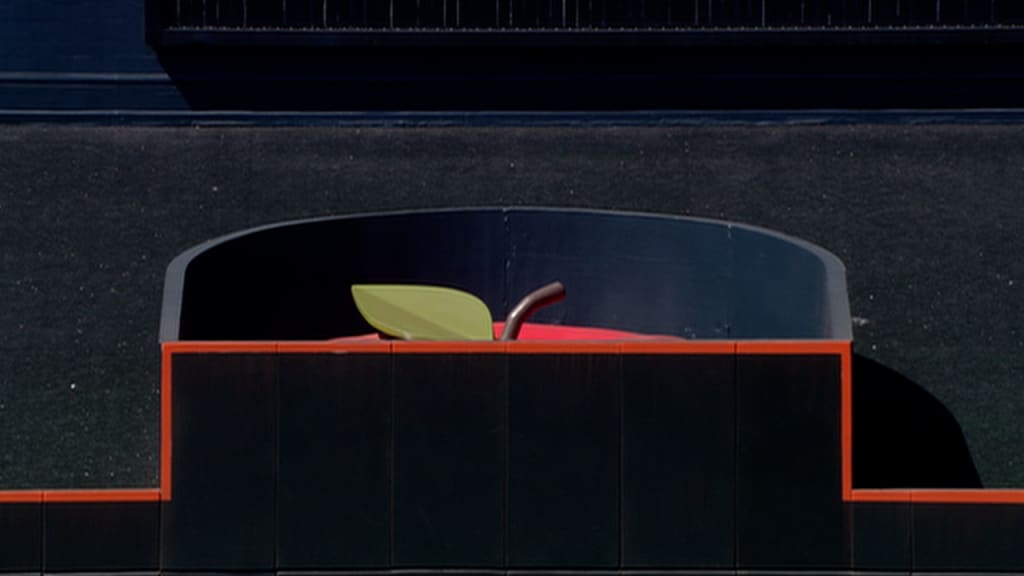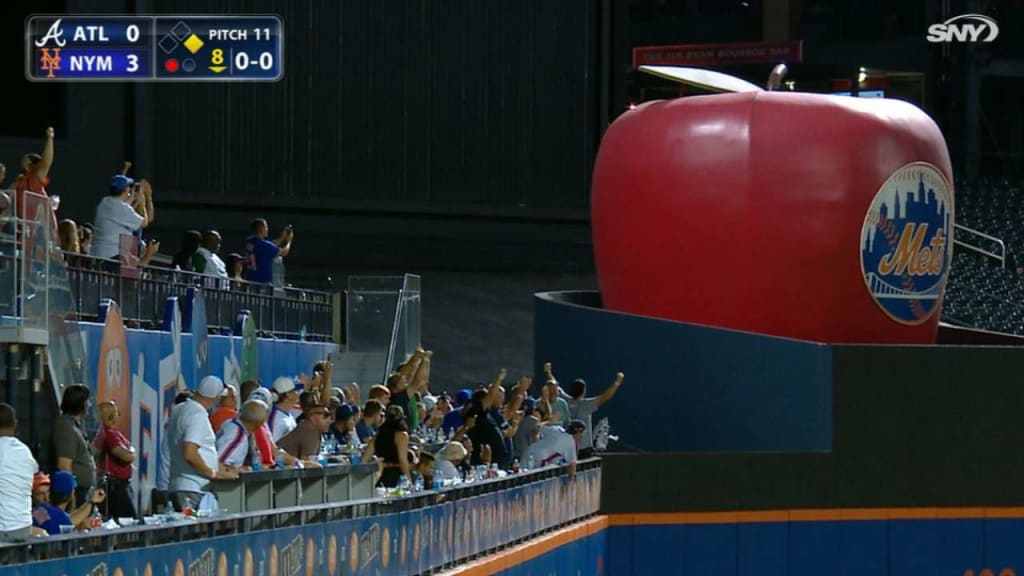Home Run Apple a beloved Mets tradition
This browser does not support the video element.
NEW YORK -- About halfway through Citi Field’s inaugural season, a horror unfolded.
Fernando Tatis Sr., then a utilityman for the Mets, hit a pinch-hit homer over the fence in left. “Cue the Apple!” Mets play-by-play man Gary Cohen exclaimed on air, expecting the sculpture beyond the center-field wall to rise as usual. But the Apple did not rise. Was it broken? Was it stuck? Thousands around the stadium began booing to the puzzlement of Tatis, as “We want Apple!” chants echoed around the ballpark.
Such is the popularity of the Home Run Apple, a sculpture that has become as much a part of franchise lore as the skyline logo or Mr. Met.
“The Mets have a very unique history that’s fun,” said Brendan McKeon, the sculpture’s current operator. “The ‘Meet the Mets’ song, Shea Stadium, Casey Stengel from back in the day … the Apple just plays into all that.”
This browser does not support the video element.
McKeon is the Mets’ director of production technology, with in-game responsibilities revolving around scoreboard graphics and data. He is one of about 15 employees who sit in the control room during games, but McKeon became the primary Apple operator simply because his workspace happens to be closest to the push button. Before each game, Citi Field workers power on the Apple via another control room in center field. From that point, it’s McKeon’s job to direct it north or south, using a button that’s kept under lock and key. The Apple typically stays up from the end of batting practice until the start of the game, then down unless a home run is hit; otherwise, it would affect the batter’s eye in center field.
So it has gone for more than four decades in Flushing, where a mechanical piece of fruit has become an institution. The original Apple dates to 1980, shortly after original owner Joan Payson’s family sold the team to a group led by Nelson Doubleday. Over the previous seven years, the Mets had failed to finish within 10 games of first place, much to their financial detriment; in 1979, their attendance fell under 1 million for the first time since the team’s inaugural season at the Polo Grounds. To combat flagging interest, Doubleday hired prominent advertising executive Jerry Della Femina, who created the slogan, “The Magic is Back.”
The Home Run Apple, which was the brainchild of longtime Mets executive Al Harazin, became a centerpiece of that campaign. At Shea Stadium, the Mets encased it in an oversized top hat with the script phrase “Mets Magic” emblazoned upon it. (The effect was meant to evoke a magician pulling a rabbit out of a hat.) It was not until years later that the Mets altered the lettering to read “HOME RUN” in all caps.
When they moved to Citi Field in 2009, team officials -- acting on the recommendation of a fan survey -- commissioned a new apple nearly twice as tall, while ditching the magician’s hat, the lettering and a light installation that flashed during home runs. The old Apple received a permanent resting place outside the park.
“It was something the fans liked,” director of alumni relations Jay Horwitz said. “It was part of our history. It was relevant to Shea. They just wanted to have Shea be a part of Citi Field.”
“The kids absolutely love it,” added longtime Mets radio voice Howie Rose. “When a Met hits a home run, they want to see that apple come up. I can see it right in front of me [from the booth]. When that apple comes up, they’re paying attention and they’re smiling.”
In those ways, the Apple serves as a form of nostalgia, evoking some of the most famous homers in Shea Stadium history: Mike Piazza’s post-9/11 shot, for example, or Robin Ventura’s “grand slam single.”
At various points in history, the sculpture itself has even played a starring role. When the collapse of a 500-pound beam at Yankee Stadium forced the Yankees to play a home game at Shea Stadium in 1998, it gave Darryl Strawberry -- a longtime Met who had cued the Apple 123 times over eight seasons with the team -- another chance to summon it.
“That definitely was a good memory,” Strawberry said after the game, “because I’ve seen it a lot of times.”
This browser does not support the video element.
The Apple again generated headlines following its 2009 malfunction, which led to a quick upgrade. At that time, the Apple’s hydraulics required around two minutes to reset, preventing it from rising when Tatis homered three pitches after Brian Schneider went deep. Following the season, the Mets installed an improved mechanism that resets in about 30 seconds.
Six years later, the Apple received a more cosmetic makeover when Travis d’Arnaud clanged a homer off it during Game 1 of the 2015 National League Championship Series. (Hitting the Apple requires an impressive poke of about 430 feet or more.)
This browser does not support the video element.
The next day, as a joke, former COO Jeff Wilpon directed stadium workers to install an oversized bandage on the spot d’Arnaud hit.
Fans loved the imagery, just as they loved the original Apple enough to convince ownership to bring it to Citi. Now, the Mets have two items in their fruit basket: the old Apple, which has become a meeting place for fans between the 7 Line subway exit and the ballpark’s main entrance, and the new one in its traditional spot in center field.
“It’s just part of Mets lore,” McKeon said. “It might seem silly to the outsider, but I think to a Mets fan, it fits right in.”

